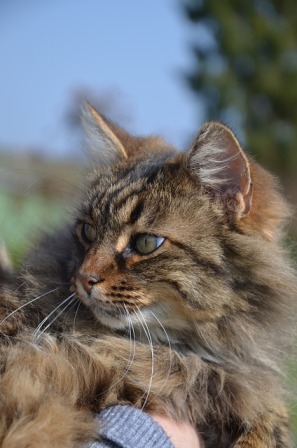Why Do Cats Lose Their Hair?
Why Do Cats Lose Their Hair?
Normal shedding cycle in cats has been determined by genetic hair’s growth cycle. This cycle develops through four stages of hair’s growth, beginning with the growth of hair, followed by the phase of regressing and rest, and finishing with shedding. As we can see, shedding is the part of a natural cycle. Apart from regular shedding, outdoor cats are prone to seasonal hair loss, like their wild ancestors. They change their fur twice a year: in the spring and in the autumn, thus preparing themselves for two main seasons: summer and winter. Many cats react with hair loss if they do not get enough nutrients from the food, or their diet misses some essential fats like omega 3 or omega 6. Very often, slightly changes in food choice can reduce and stop shedding. If the cat sheds excessively, and the seasonal changes and poor diet are excluded, then the reason for that can be one of the following, described in the article “Diseases with Hair Loss in Cats”.
Why Do Cats Lose Their Hair?
Many of these conditions are related to hormone production.
• Congenital hypotrichosis: A genetic condition where kittens lose any hair they are born with by about 4 months of age.
• Cortisone excess: Symmetrical hair loss over trunk and body, with darkening of the underlying skin. Seen with Cushing’s disease. May also indicate a
thyroid problem. Thinning of the skin is also seen with this condition.• Demodectic mange: Thinning and loss of hair around the eyes and eyelids, giving the cat a moth-eaten appearance. Not common in cats.
• Eosinophilic granuloma: Raised, red circular plaque on the abdomen or insides of the thighs (eosinophilic plaque); or linear plaques on the backs of the
hind legs.• Feline endocrine alopecia: Thinning or balding of the coat on insides of the back legs, lower abdomen, and genital area. Distribution is symmetrical.
Occurs most often in neutered males and spayed females.• Hyperthyroidism (excess thyroid hormone): About one-third of cats with this endocrine problem will have hair that pulls out easily and hair loss.
• Hypothyroidism (deficient thyroid hormone): Dry skin and thinning of the haircoat. Hair becomes dull and brittle. Rare in cats.
• Indolent (rodent) ulcer: Red shiny patches of hairless skin. Usually involves the middle of the upper lip and occasionally the lower lip. Not painful.
• Psychogenic alopecia: Thinning of hair in a stripe down the back or on the abdomen. Caused by compulsive self-grooming.
• Ringworm: A fungal infection. Scaly, crusty, or red circular patches 1?2 to 2 inches (12 to 50 mm) across. Patches show central hair loss with a red ring
at the periphery. Sometimes just broken hairs around the face and ears. May become infected. Highly contagious, including to humans.• Stud tail: Greasy, rancid-smelling waxy-brown material at the top of the tail near the base. The site of the glands is usually devoid of hair.
Very often, cats react with hair loss when feel stressed. Every change in cats’ habits, in their close environment or when moving a house, etc. can cause hair loss. One of such events that can disturb the cat is travelling, and the cat which is not well accustomed to a car ride when young, can experience very intense shedding during a ride. For that cat, finding a cat’s hostel or someone to take care of it during its owner’s absence can be a great solution. In any case, excessive shedding is not normal phenomenon, and requires the owner’s attention.










